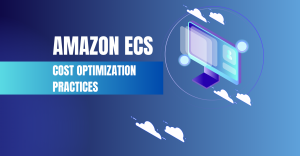
Azure ACR Cost Optimization Practices
What is Azure Container Registry? Azure Container Registry (ACR) is a fully managed container image registry service provided by Microsoft Azure. It allows developers to
Check out the latest industry insights from Amadis Technologies’ thought leaders and technical experts in our selection of exclusive blogs.





What is Azure Container Registry? Azure Container Registry (ACR) is a fully managed container image registry service provided by Microsoft Azure. It allows developers to

What is Amazon ECS? Amazon Elastic Container Service (Amazon ECS) is a fully managed container orchestration service designed to simplify the deployment, management, and scaling of containerized applications. It seamlessly integrates with Docker and AWS services such as Amazon Elastic Container Registry (ECR), enabling organizations to provide a scalable and cost-effective environment for running containerized workloads on AWS. How Amazon ECS Works? An Amazon ECS cluster is a logical grouping of tasks or services. Tasks and services are run on infrastructure registered to the cluster, which can include: AWS Fargate: A serverless compute engine that eliminates the need to

What is Databricks? Databricks is a fully managed cloud-based unified analytics platform built on Apache Spark. It provides a collaborative environment for data engineers, data scientists, and analysts to process big data, conduct data science, and implement machine learning workflows. Databricks simplifies the use of Spark by offering a managed environment where users can spin up clusters, collaborate using interactive notebooks, and access various built-in libraries for analytics, machine learning, and data engineering tasks. This platform not only streamlines the development and deployment of big data applications but also promotes an environment of teamwork and innovation, enabling organizations to

Azure SQL Database cost optimization is a much sought after request we get from our customers. Azure SQL Database is a powerful, fully managed database-as-a-service (DBaaS) that eliminates the need for businesses to handle maintenance, security, and reliability. Despite its versatility, effectively managing costs within Azure SQL Database can be complex, especially when dealing with different purchasing models and configuration options. This is where CloudCADI steps in, providing the insights and automation necessary to optimize your Azure SQL Database investments. Azure SQL Database Overview Azure SQL Database offers flexibility with two main purchasing models: vCore-Based Purchasing Model: Customization: Users

Cloud has become an integral component for successful business operations. However, alongside the benefits of cloud computing come the complexities of managing costs effectively. Enter Cloud FinOps, a discipline aimed at optimizing cloud spending while maximizing value. It continues to be one of the top cloud priorities in 2024 and the coming years. As organizations embark on this new journey, numerous questions arise regarding FinOps practices. This article covers a few with responses from our cloud finops experts themselves Kathick Perumal, Product Engineering Head and Mukesh Kumar, our Product Architect who holds profound experience in tackling cloud finops challenges

As businesses continue to embrace Kubernetes for its scalability and agility, cost management becomes increasingly critical. We understand that managing cloud costs can be complex, especially in large and dynamic containerized environments. That’s why we’re here to provide you with practical insights and actionable tips to take control of your Kubernetes spending. In our previous blog on Kubernetes Cost Optimization Best Practices – Part 1, we covered the common cost optimization challenges and a few solutions. Let’s see a few more, Taints & Tolerances In Kubernetes, “taints” and “tolerations” are mechanisms that can be used strategically to optimize costs

Cloud FinOps products & tools are essential for enterprises to effectively manage, optimize, and control their cloud costs. They offer a plethora of benefits allowing organizations to make data-driven decisions, achieve cost savings, and maximize the value of their cloud investments. Let’s dig deep into some of its benefits. What Are The Benefits of Cloud FinOps Tools? 1. Cost Optimization: They tell you where you can save. Cloud FinOps tools help enterprises optimize their cloud spending by providing insights into usage patterns, identifying cost-saving opportunities, and enabling effective cost-management strategies. They allow to monitor and control cloud costs, avoid

We use cookies and similar technologies on our website and process your personal data (e.g. IP address), for example, to personalize content and ads, to integrate media from third-party providers or to analyze traffic on our website. Data processing may also happen as a result of cookies being set. We share this data with third parties that we name in the privacy settings.
The data processing may take place with your consent or on the basis of a legitimate interest, which you can object to in the privacy settings. You have the right not to consent and to change or revoke your consent at a later time. For more information on the use of your data, please visit our privacy policy.
Below you will find an overview of all services used by this website. You can view detailed information about each service and agree to them individually or exercise your right to object.
Essential services are required for the basic functionality of the website. They only contain technically necessary services. These services cannot be objected to. • Show service information